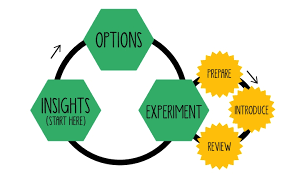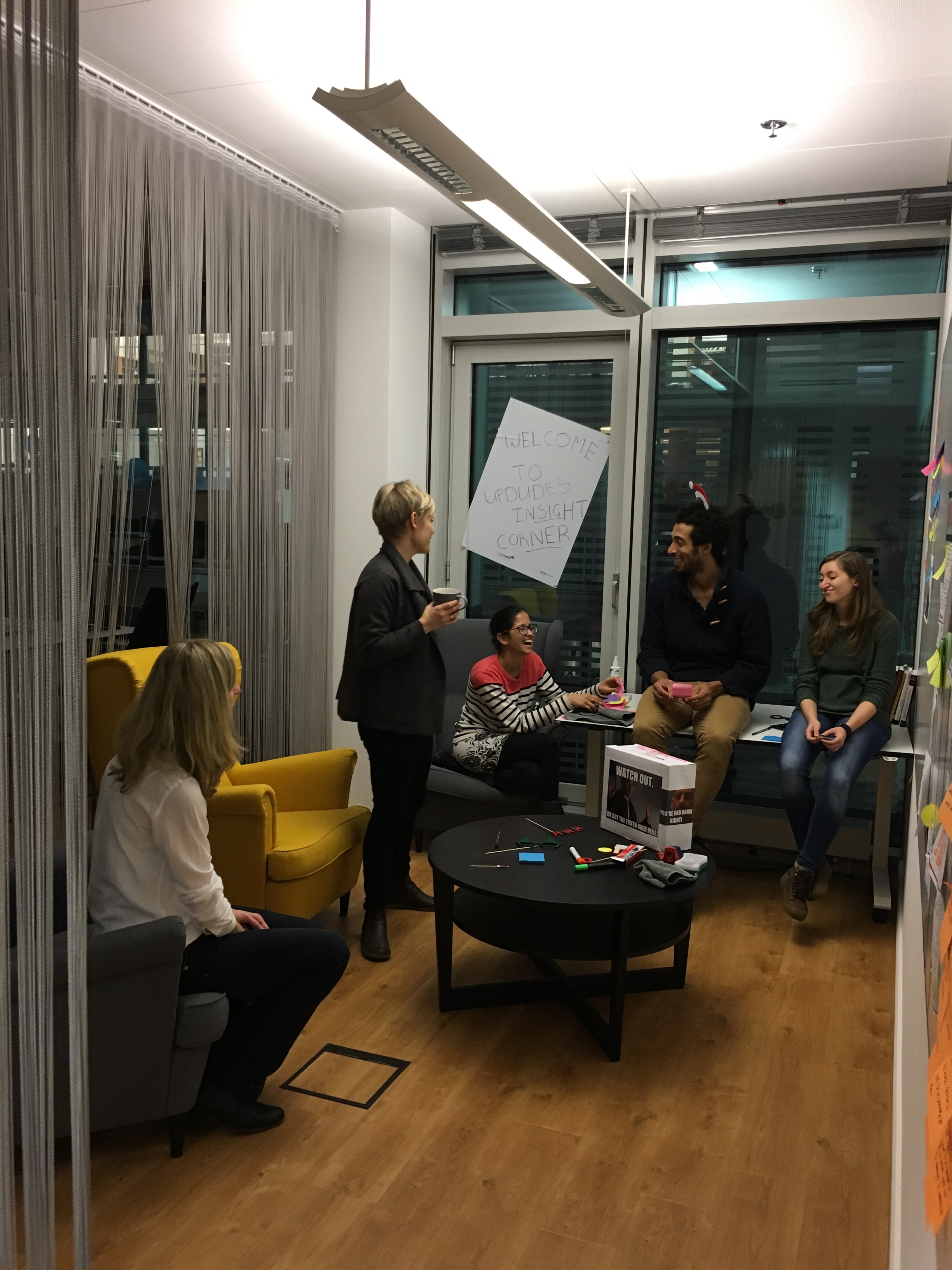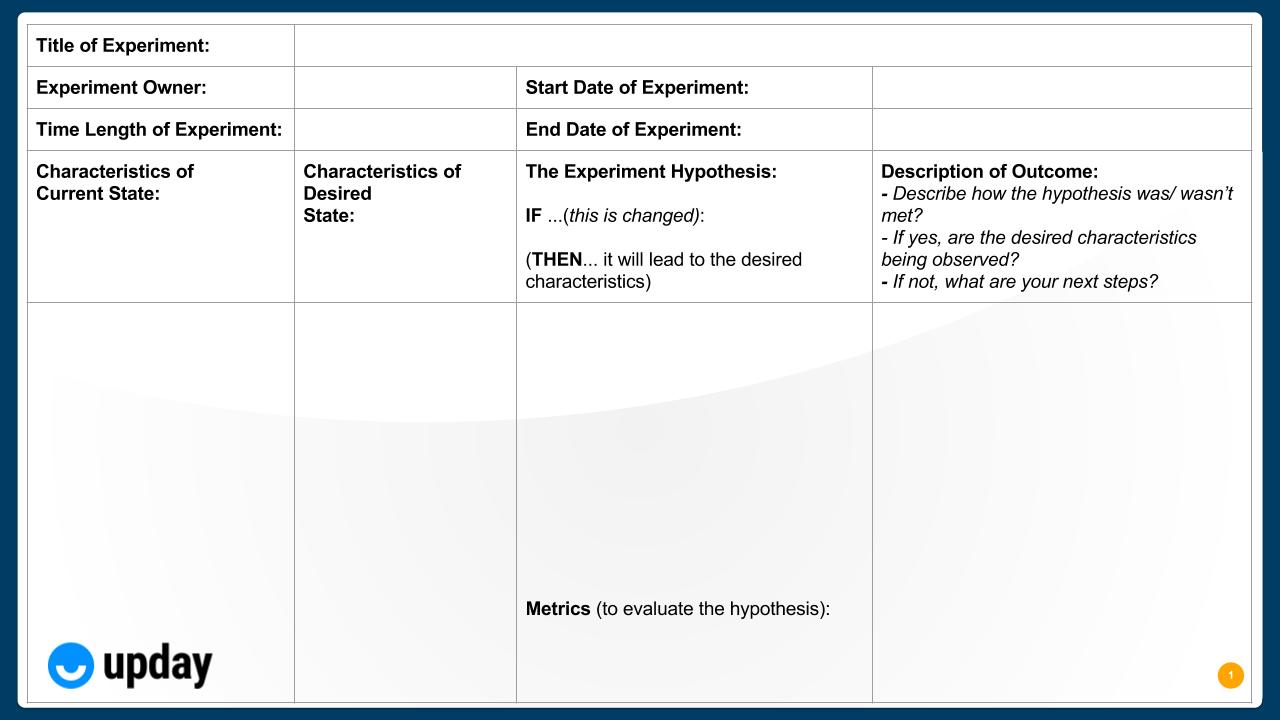Stop: New Year’s ResolutionsStart: Experiments
8 minutes readA new year comes with the feeling that now is the time to change things. How many of us started the year with a promise to change and a few days later, it was already broken? Once a year, big-bang changes don’t work - it never did and never will. Instead, change things when and where you feel the need to. At upday, we strive to continuously improve; how we work and what we deliver. This requires constant change.
How do we foster an organization where the changes are based on what is truly going on in the organization and its surroundings? Where change is not driven by a few, but by anyone who sees the need for change? Where change is not planned upfront and executed top-down but as small steps involving people who are affected? Where we all take part in shaping the future of the organization we want to work in and where we can deliver excellence?
Where Did We Start?
I (Agile Coach at upday) joined a Lean Change Agent workshop together with Richard, one of our Data Scientists, and our CTO Andi. It was a two day workshop held by Mike Weber and based on the book by Jason Little: Lean Change Management. It was an active workshop including lots of participation and interactions, with great tools and ideas about how to work with change in an organization.
We were introduced to a way of approaching change by collecting insights and from these, create small experiments that you evaluate and learn from before you take the next step. The idea is that instead of planning the change upfront, to create small experiments based on your current understanding and insights gathered, and review these after a fixed time period. The word experiment is important here since it emphasizes that until we have tried something out; verified our assumptions (hypotheses) based on predefined metrics, we don’t know whether it’s the right thing to do and if our change will be successful. Another key ingredient is to involve people affected by the change in designing the change. This is called the Lean Change Management cycle and it’s a feedback-driven model for managing change.

The Insights Board Was Born
Collecting insights is about trying to understand the current state (of the organization). This does not happen in a meeting room where managers discuss their opinions and ideas based on their assumptions on how the organization is running. To really try to understand, I have to gather opinions, thoughts, reactions from people working IN the organization. One way of collecting insights is through an “insights board”.
Inspired by the stories shared to us during the workshop, as we came back to the office, Andi set up our first insights board. He basically did a braindump of his own insights, grouped them and invited others to add, group and vote. It was done very informally and spontaneously by different updudes (as we call ourselves working at upday) or alone if we had the time and inspiration.

Although we were quite overwhelmed by all the post-its, we felt that what we found there was not news to us. We more or less had a similar perception of how things were working in our organization. We were aware of what our problems were. The question was what to do with this knowledge. It’s quite amazing, we actually had a lot of collective experience, knowledge and feelings about our organization there on the wall and we could just use it to start changing things.
Unfortunately, it wasn’t that simple. We were often too busy with other things that we didn’t take enough time to spontaneously reflect, especially not in a small group. However, we strongly believe that working with insights and experiments is the right way to go and we need to create time for it and continuously improve how we approach change.
Iteration 1: Introduce Structure
We started to get a bit frustrated about all the things we wanted to do, but just didn’t manage to. At about the same time, we also realized that we needed to introduce more structure to the board and the process; how do we follow-up, what do we do with the insights and outcome of experiments, what about responsibilities? At this point, Jessica Criddle joined us as Agile Coach. She came with a fresh mind, new perspective and lots of energy. This helped a lot to light the spark again. We did a first draft of how the process could look.

Iteration 2: Simplify
The process looked quite good on paper and it did help us to get a clear, shared picture, but it was a bit too much. To actually make the Insights board something we all used, we had to simplify. So we did. We cleaned up the board, made some simple rules, made an effort to make it a regular habit to work in front of the board. It was a new start! Two updudes also assigned themselves new roles; “Lord of the board” and “Master of cluster” with the responsibilities to make people gather around the board and help them use it.
When creating an experiment, it is important to include a hypothesis; what outcome do you expect after running the experiment?
“IF this is changed THEN it will lead to these characteristics.”
You also have to decide how to measure the outcome; when the experiment is over and you review it, how do you know if it succeeded or not? As a means to simplify, we introduced a template for creating experiments, which made it easier to get started. The template included all steps needed to create an experiment and how to review it.

To make it more clear what an experiment could look like, here are a few examples of hypotheses from our experiments:
- “IF we change the team setup in the suggested way, THEN we gain productivity for delivering on focus areas and our happiness at work will increase.”
- “IF team uses End-of-Day emails as daily standup, THEN it will fulfill the purpose of the standup and keep team concentration.”
Iteration 3: Involve And Empower
Gradually it spread how to use the insights board and how all updudes could get involved in changing upday. We made a collective effort to make the board alive and active and actually use the insights posted there.
It was a positive peer pressure; “join me, let’s spend some minutes at the insights board” after the weekly all-hands or by encouraging each other to use the insights board and create an experiment when something not working so well in the organization was addressed. The idea is to empower everyone to do something - to own the possibility to change and shape our future!
It’s important to note that an experiment could be around anything you believe should change in your organization; culture, processes, tools, roles. It could be something concerning the whole organization or just a few people. The key (again) is not to have people with fancy titles plan upfront at the computer, but to involve people affected by the change in designing it. Empower and encourage them to drive the change!
Learnings
Along this journey, we learned a lot about ourselves and how to approach change with the help from an insights board. Using insights works best if we have a high level of trust; we have to be really open and honest with each other when we post insights. This is something we always have to work on and we’ll admit: we are not there yet. Also, to make sense for anyone to post insights, we have to actively use the things posted there. Turn insights into experiments, continuously drive change in small steps, involving people affected. If we don’t, we lose trust in the board and the process and it goes stale.

Another thing that we learned is that it’s easy to lose focus after the experiment is done, but in order to see what works for you and for change to really happen, it’s important to focus on the review. Look at the metrics, evaluate the outcome, and decide on the next steps. Persevere or pivot. This, and taking small steps, is two key ingredients to lean change management.
The Future
We have approached our insights board in an iterative way. It is an experiment that will gradually evolve. How we use it and how it is designed will change step-by-step as we see what works for us and what doesn’t.
In a future post, we will give more details on where this journey took us: how the insights board and the experiments helped us to improve.